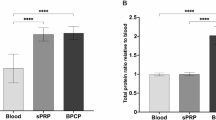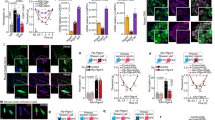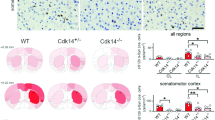Abstract
We have shown recently that adaptive changes in the apparent amount of enzymes which synthesize and inactivate prostaglandins (PGs) occur in a reciprocal manner (see accompanying paper1 and refs 2–4). For example, PG synthetase activity in several rat organs is reduced but that of PG-metabolizing enzymes (‘prostaglandinases’) is increased after treatment with anti-inflammatory steroids1. In view of recent reports that the synthesis of PG-like substances may be influenced by plasma factors5–7, we wondered whether our findings may be explained in whole or in part by the presence in varying amounts of substances which affect PG synthesis and inactivation in opposite directions. We show here that rat plasma contains a protein factor(s) which inhibits the synthesis of PGs and enhances their enzymatic breakdown in vitro and which we provisionally call prostaglandin ‘reciprocal coupling factor’ (RCF). Furthermore, RCF is rapidly released in response to anti-inflammatory steroids and its levels are altered in the two model pathophysiological states so far investigated.
This is a preview of subscription content, access via your institution
Access options
Subscribe to this journal
Receive 51 print issues and online access
$199.00 per year
only $3.90 per issue
Buy this article
- Purchase on SpringerLink
- Instant access to full article PDF
Prices may be subject to local taxes which are calculated during checkout
Similar content being viewed by others
References
Moore, P. K. & Hoult, J. R. S. Nature 288, 269–270 (1980).
Hoult, J. R. S. & Moore, P. K. Br. J. Pharmac. 69, 272–273 (1980).
Hoult, J. R. S. & Moore, P. K. Clin. Sci. 59, 63–66 (1980).
Hoult, J. R. S., Moore, P. K., Marcus, A. J. & Watt, J. Ag. Actions Suppl. 4, 232–244 (1979).
Saeed, S. A. et al. Nature 270, 32–36 (1977).
Herman, E. A., Yamamoto, M. & Rapoport, B. J. cell Physiol. 100, 401–406 (1979).
MacIntyre, D. E., Pearson, J. D. & Gordon, J. L. Nature 271, 549–551 (1978).
Putnam, F. W. in The Proteins Vol. 3, 2nd edn (ed. Neurath, H.) 153–267 (Academic, London, 1965).
Bills, T. K., Smith, J. B. & Silver, M. J. Biochim. biophys. Acta 424, 303–314 (1976).
Isakson, P. C., Raz, A., Denny, S. E., Wyche, A. & Needleman, P. Prostaglandins 14, 853–871 (1977).
Moore, P. K. & Hoult, J. R. S. Prostaglandins 16, 335–350 (1978).
Takeguchi, C., Kohno, E. & Sih, C. Biochemistry 10, 2372–2376 (1971).
Rose, A. J. & Collins, A. J. Protaglandins 8, 271–283 (1974).
Wlodawer, P., Kindahl, H. & Hamberg, M. Biochim. biophys. Acta 431, 603–614 (1976).
Collier, H. O. J., Denning-Kendall, P. A., McDonald-Gibson, W. J. & Saeed, S. A. in Haemostasis, Prostaglandins and Renal Disease (eds Remuzzi, G., Mecca, G. & de Gaetano, G.) (Raven, New York, in the press).
Hong, S. L. & Levine, L. J. biol. Chem. 251, 5814–5816 (1976).
Remuzzi, G. et al. Thromb. Res. 13, 1007–1015 (1978).
di Rosa, M., Capasso, F. & Mascolo, N. in Advances in Inflammation Research Vol. 1 (eds Weissmann, G., Samuelsson, B. & Paoletti, R.) 493–498 (Raven, New York, 1979).
Hoult, J. R. S. & Moore, P. K. Br. J. Pharmac. 61, 615–626 (1977).
Author information
Authors and Affiliations
Rights and permissions
About this article
Cite this article
Moore, P., Hoult, J. Pathophysiological states modify levels in rat plasma of factors which inhibit synthesis and enhance breakdown of PG. Nature 288, 271–273 (1980). https://doi.org/10.1038/288271a0
Received:
Accepted:
Issue date:
DOI: https://doi.org/10.1038/288271a0
This article is cited by
-
The effects of oral nafazatrom (=BAYg 6575) on canine coronary artery thrombosis and myocardial ischemia
Basic Research in Cardiology (1983)
-
The primary prostaglandin-inactivating enzyme of human placenta is a dimeric short-chain dehydrogenase
Bioscience Reports (1982)
-
Anti-inflammatory steroids reduce tissue PG synthetase activity and enhance PG breakdown
Nature (1980)



